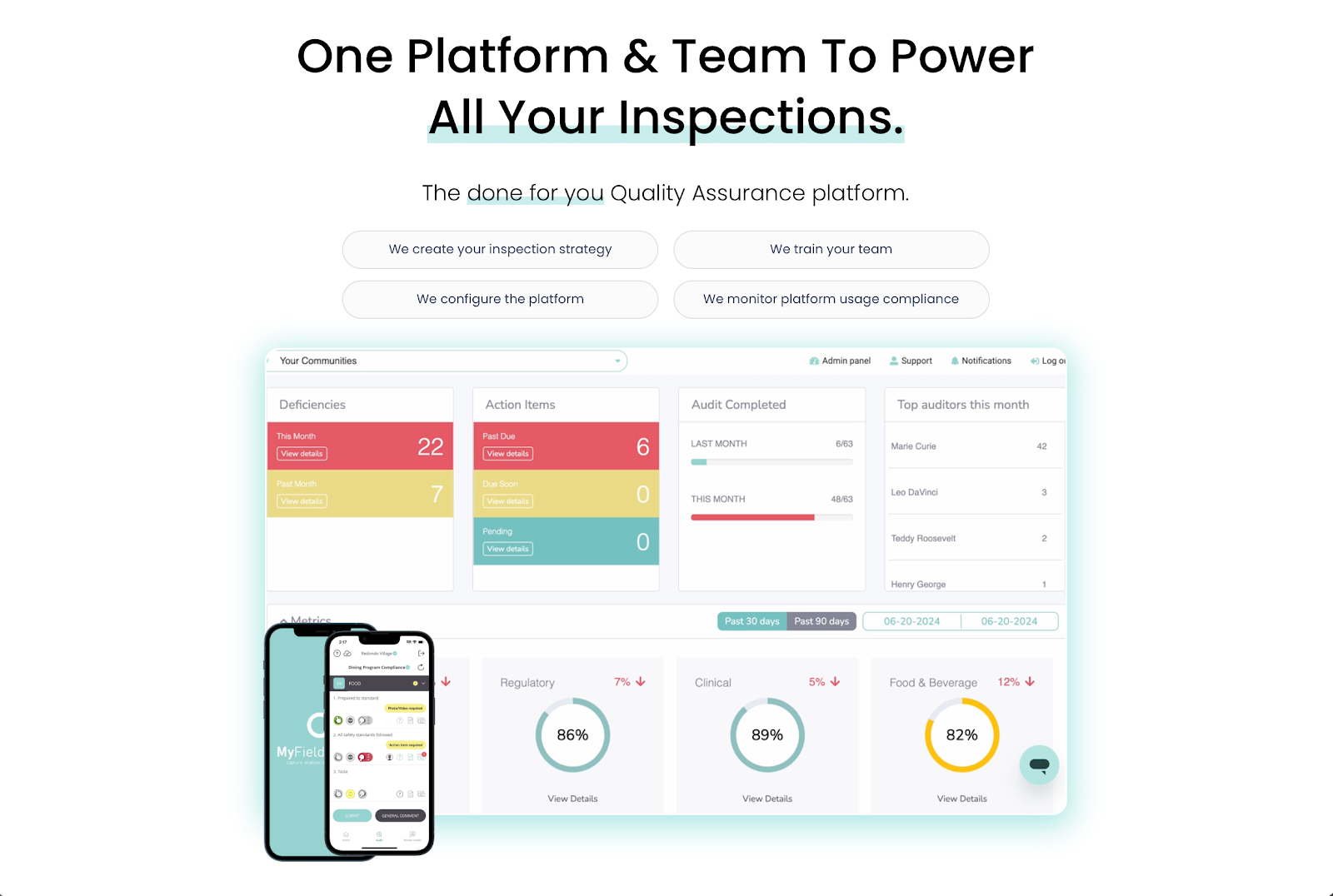.svg)
10 Facility Management Best Practices for Success

Take Control of QA.
Make Inspections Effortless.

We’ll quickly uncover your needs and share how we can help—no pressure, no stress, just solutions. Grab your spot on our calendar today!
Be survey-ready every day with three simple dining audits

We’ll quickly uncover your needs and share how we can help—no pressure, no stress, just solutions. Grab your spot on our calendar today!
Managing a facility, whether it’s an industrial plant, restaurant chain, or assisted living community, requires constant attention and coordination.
You need to keep buildings safe, equipment running, teams on task, and clients happy, often across multiple locations. Without the right systems in place, small issues can quickly grow into expensive problems.
Implementing effective facility management practices makes a difference. The best operators don’t simply react to problems; they prevent them from happening in the first place.
By building clear routines and using the right tools, you improve consistency and accountability across every site you manage.
This guide covers the best practices for facility management that help you save money, stay compliant, and maintain the high standards your clients and regulators expect.
1. Conduct Regular Inspections
Many facility managers overlook inspections because they can feel overwhelming or time-consuming. However, skipping them often leads to bigger and costlier problems later.
Regular inspections are the foundation of strong facility management. They help you spot small issues before they turn into safety hazards, compliance violations, or equipment breakdowns.
Use a structured facility inspection checklist to keep your audits consistent across all locations. Cover different areas of your facility, such as building maintenance, electrical components, plumbing systems, and exterior facility maintenance.
Then, integrate inspections into your weekly or monthly routine, depending on your facility's size and activity level.
Consistent inspections reduce unexpected repairs, align different teams, and create a culture of accountability. They also build confidence with leadership and clients because they show you’re maintaining high standards.
2. Choose the Right Facility Management Software
The right facility operations software can enhance multi-site management. It helps you see what’s happening across all locations in real time instead of sorting through spreadsheets or chasing people down.
Digital platforms also improve operational efficiency by reducing paperwork and manual hand-offs.
You can instantly spot issues and monitor performance at a glance through detailed dashboards. This way, you make better-informed decisions based on real-time data.
The best facility management software depends on your specific operational needs and facility type. A large industrial site won’t need the same tools as a restaurant chain or an assisted living community.
When comparing software options, focus on what matters most to your daily operations. For example, if you manage a warehouse, look for inventory and asset management features.
Restaurant owners should invest in food software that helps manage safety compliance, inventory, and supply chains. Meanwhile, assisted living facilities should prioritize health and safety management.
Many facilities management teams, regardless of industry, benefit from mobile accessibility, advanced reporting tools, extensive integration options, and reliable vendor support.
3. Prioritize Safety and Compliance
Safety and compliance are critical aspects of any strong facility management checklist. They protect employees, clients, and visitors while keeping operations legal and consistent across multiple locations.
Whether you manage industrial plants or commercial buildings, a single missed safety rule can lead to serious incidents or costly violations.
You can follow these steps to strengthen your facility’s processes around safety and compliance:
- Establish clear safety protocols: Develop written procedures for equipment use, sanitation, staff hygiene, and incident reporting. Review and update them often.
- Train your staff regularly: Everyone should know how to respond to fires, earthquakes, or medical emergencies. Reinforce learning with regular training programs and drills.
- Maintain accurate documentation: Store records digitally so they’re easy to access during internal audits or inspections.
- Encourage safety reporting: Empower facility team members to report hazards immediately. Instant reporting prevents small risks from becoming major problems.
4. Embrace Sustainability and Energy Efficiency
Sustainability is no longer optional when managing facilities. It’s a smart business practice that benefits not only your bottom line but also the environment.
Using energy-efficient systems helps lower utility bills, reduce waste, and limit your facility’s environmental impact. For operators managing multiple sites, even small changes can lead to major cost savings over time.
According to ENERGY STAR, more than 430 industrial facilities partner with the U.S. Department of Energy (DOE) and the program. This has helped businesses save billions of dollars on energy costs and cut their greenhouse gas emissions.
To adopt sustainability, start by upgrading your facility lighting to LED fixtures. They use less power and last longer than traditional bulbs.
You can also use high-efficiency HVAC systems to reduce energy usage while improving indoor air quality.
Consider installing energy-efficient windows that help maintain a comfortable temperature and cut heating or cooling costs.
You can even adopt environmental sustainability initiatives, such as recycling programs, water-saving fixtures, and switching to renewable energy sources like solar panels.
Don't forget to conduct regular energy audits and track data to identify waste. This helps you prioritize upgrades and create greener operations faster.
5. Develop Preventive Maintenance Plans
Relying on reactive repairs can lead to downtime, safety issues, and costly emergency repairs. Production stops, staff lose time, and expenses pile up when important equipment breaks unexpectedly.
Reactive maintenance costs are often higher than planned maintenance because they involve urgent service requests, rush parts, and lost productivity.
You should focus on preventative maintenance to ensure business continuity, extend equipment life, and reduce costs.
Conduct regular maintenance activities that keep your facility's assets in good working condition before they fail. This usually involves cleaning, calibration, part replacements, and system testing.
Follow a regular maintenance schedule for all equipment across your facilities. Use asset management software to track work orders, reminders, and current task status.
Train your staff to report early warning signs like leaks, unusual sounds, or performance drops. This helps you address issues quickly before they result in downtime.
6. Maximize Space Utilization
Many facilities have unused or poorly arranged areas that lead to clutter, wasted energy, and low productivity.
As a facility manager, your goal is to organize every square foot to support daily work and safety. Making the most of your available space also improves facility efficiency and reduces unnecessary costs.
Evaluate how each area is used. Review layouts for production zones, office space, and storage areas.
You should also remove unused equipment, rearrange workstations, and create flexible layouts that adapt to changing needs.
Good facility work practices include labeling zones, using vertical storage, and setting clear paths for movement.
When your building infrastructure is designed around how people actually work, you improve comfort, safety, and output, all without expanding your footprint or increasing overhead.
7. Prepare for Emergencies
Your facility layout should also support faster responses during emergencies. Clear paths and labeled areas make evacuation safer and more efficient.
Although you can’t predict when an incident will happen, you can plan for it.
Start by identifying potential risks for your facility, such as fires, power outages, chemical leaks, or severe weather.
Develop written procedures for each situation and make sure all employees know their roles. Conduct drills regularly to train staff on how to act quickly under pressure.
You should also inspect building systems like sprinklers, alarms, and backup generators to confirm they work properly. Keep emergency kits and first-aid supplies accessible in multiple locations.
If you manage several facilities, store digital copies of all emergency preparedness plans in a shared platform for quick access.
8. Adopt IoT Technologies
The Internet of Things (IoT) refers to connected devices that collect and share data in real time. In facilities, this includes building automation systems that control lighting, temperature, and security.
IoT devices help you monitor facility management operations without being on-site. They also support data-driven decision-making.
Below are some popular examples of IoT used in facilities:
- IoT sensors can track equipment performance and send alerts before a breakdown occurs. They reduce downtime and allow your team to plan maintenance tasks instead of reacting to failures.
- Smart meters monitor water and energy consumption. These help you identify waste and reduce operating costs.
- Automated lighting and HVAC controls adjust settings based on occupancy to improve efficiency and save power.
- Security cameras detect safety risks, monitor employee activity, and prevent theft or damage.
9. Strengthen Contractor and Vendor Management
Strong contractor and vendor relationships are key to smooth facility operations management. Poor coordination often leads to delays, budget overruns, and inconsistent service quality.
Facility managers can avoid these issues by setting clear expectations and tracking performance from the start.
Define service-level agreements (SLAs) that outline response times, work quality, and safety standards. Review these regularly to make sure vendors meet expectations.
Use centralized tools or software to assign tasks, share updates, and confirm project completion. Then conduct regular check-ins to foster effective communication, stay up to date, and prevent misunderstandings.
When you treat vendors as long-term partners rather than short-term suppliers, you build trust and improve retention.
10. Invest in Training and Continuous Improvement
Training should be part of your long-term strategic plan, not a one-time effort. A well-trained team keeps your facilities running smoothly and safely.
You should identify knowledge and skill gaps. Common improvement areas include preventive maintenance, safety procedures, energy management, and new technology use.
Use hands-on demonstrations, checklists, and gamified lessons to make training practical and easy to follow. Encourage feedback after sessions to find ways to improve.
After several months, provide regular refreshers to reinforce learning and retain important knowledge.

Benefits of Implementing Facility Management Best Practices
Adopting the best practices for facility management can benefit your daily operations in several ways:
Maintain High Standards Across Locations
Conducting facility inspections and following regular maintenance schedules can improve consistency across multi-site operations.
Facility teams understand what’s expected of them, which helps avoid confusion and reduce errors. Meanwhile, managers immediately see what's happening on the ground and fix issues fast.
Reduce Operational Costs
Poor visibility leads to wasted time, money, resources, and energy. When you adopt facility management best practices and monitor performance closely, you cut unnecessary spending.
For example, preventive maintenance reduces downtime and extends equipment lifespan. On the other hand, sustainable practices increase energy efficiency and cost savings.
Digital software, while requiring initial investment, can also minimize operational costs in the long term. It provides real-time insights into operations, so you can address issues and make cost-saving decisions faster.
Strengthen Regulatory Compliance
Compliance becomes easier when you follow structured routines. Facility management best practices keep your documentation organized, inspections consistent, and safety procedures clear.
With everything recorded properly, audits and reviews become faster and less stressful. Instead of scrambling for paperwork, you can instantly show regulators accurate and up-to-date records.
This approach ensures regulatory compliance, helping you avoid fines and legal implications.
Enhance Workplace Safety
When safety becomes part of your facility management routine, you can reduce accidents. Regular training, inspections, and reporting keep different teams aware and alert of hazards.
Safer workplaces also mean fewer interruptions, lower insurance costs, and higher morale.
Over time, safety practices can also improve brand reputation and attract top talent to work for your facility.
Retain Clients
Clients stay loyal when they see consistent quality and transparency. Following best practices gives them confidence that their facilities are being managed carefully and efficiently.
Regular inspections and detailed reports reveal what’s happening, how often, and how well across different locations.
When clients see proof of performance, they’re far more likely to renew contracts and recommend your services to others.
Improve Facility Management With MyFieldAudits

MyFieldAudits helps you manage facilities consistently and maintain compliance across all locations. It conducts real-time inspections anywhere to provide instant clarity into your daily operations and resolve issues faster.
Mobile inspections automatically sync to detailed reports that you can share with leadership teams or clients. Everyone stays aligned and informed without lifting a spreadsheet.
However, MyFieldAudits is more than a mobile inspection platform. It acts as your retention engine by handling the heavy lifting for you, from software configuration to compliance tracking.
Industry experts will also develop a quality assurance program perfect for your facility's context to drive operational excellence. This provides clients with peace of mind knowing that inspections are fully managed.
Request a demo today to keep quality and compliance consistent across all facilities! You can also check this product overview to see how MyFieldAudits handles it all so you can get back to what you do best.
FAQs About Facility Management Best Practices
What are the four pillars of facility management?
The four pillars of facility management are people, processes, technology, and buildings. People perform the work, processes set the standards, technology improves efficiency, and buildings represent the physical space being managed. Balancing all four keeps operations stable and productive.
What are the four Ps of facility management?
In facility management, the four Ps refer to People, Process, Place, and Performance. These elements help you create consistent, efficient, and sustainable operations.
What should an FM be able to do to be effective?
A facility manager (FM) should plan, organize, and monitor all operational activities. They need to ensure safety, compliance, and maintenance while improving efficiency and reducing costs.
Effective facility managers also communicate clearly, manage vendors, and use data to make informed decisions that keep buildings running smoothly.
What are the 11 core competencies of a facility manager?
According to the International Facility Management Association (IFMA), the 11 key competencies of a facility manager are:
- Leadership and strategy
- Communication
- Project management
- Operations and maintenance
- Sustainability
- Finance
- Occupancy and human factors
- Performance and quality
- Risk management
- Information and technology management
- Real estate
These cover the essential skills and knowledge areas needed for effective facility management.
%201.svg)






%201%20(1).svg)